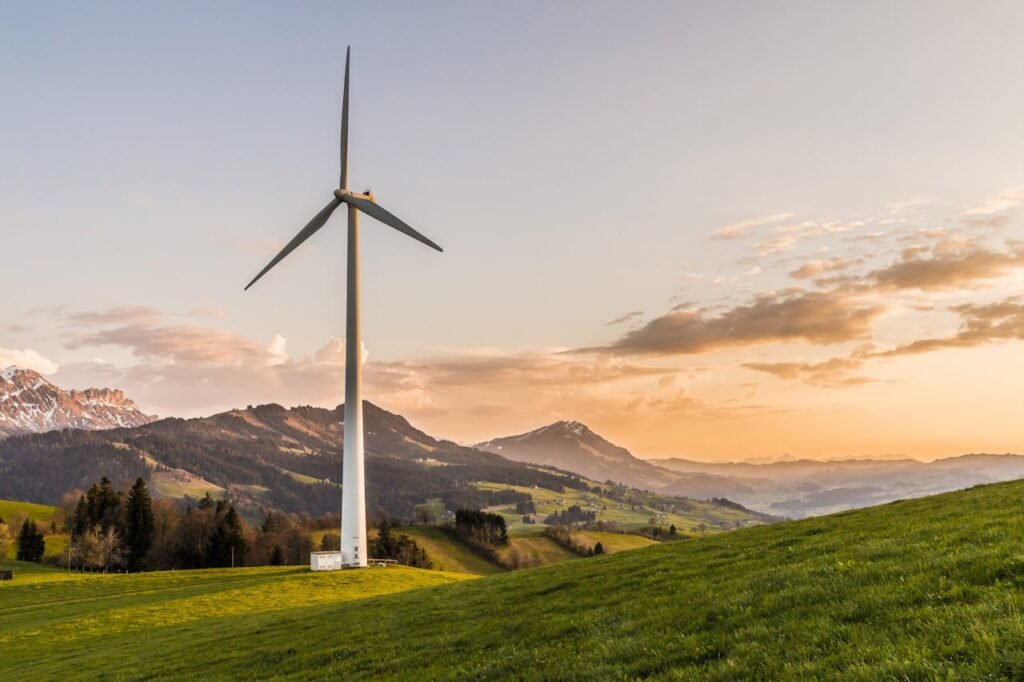If you’ve ever ridden a bike downhill, jumped on a trampoline, or even stretched a rubber band, you’ve already used energy. Energy is what makes things move, light up, heat up, and change. It’s everywhere — in the food you eat, the sunlight streaming through your window, and the battery in your phone.
But not all energy is the same. Sometimes it’s moving and active, like a speeding skateboard. Other times it’s stored and waiting to be used, like water behind a dam. Scientists call these kinetic energy and potential energy — and there’s a whole world of fascinating “in-between” types that connect them.
In this guide, we’re going to explore energy in the simplest way possible. You’ll see how it works in your daily life, how it changes from one form to another, and how understanding it can make you smarter about science — and even the world around you.
What Exactly Is Energy?
Energy is the ability to make something happen — to move something, change something, or make it warmer or brighter. Without energy, nothing would move, grow, or work. It’s what powers your body, your home, and even the whole planet.
Think of it like this:
- When you run, jump, or throw a ball — you’re using energy from the food you’ve eaten.
- When a lamp glows, it’s using energy from electricity.
- When the sun warms your face, it’s sending energy across space in the form of light and heat.
Energy isn’t always easy to see. Sometimes you notice it because something is moving or making noise. Other times, it’s there quietly, stored and ready to be used later.
The Two Main Types – Kinetic and Potential
There are many forms of energy, but scientists often start by talking about two main types: kinetic and potential.
Kinetic Energy – Energy in Motion
Kinetic energy is the energy of movement. Anything that’s moving has kinetic energy — whether it’s big like a truck or tiny like a drop of rain falling from the sky.
The faster something moves, the more kinetic energy it has. The heavier something is, the more kinetic energy it has when it moves.
Examples kids know:
- A rolling soccer ball.
- A bird flying through the air.
- A swing moving back and forth.
Even sound is a type of kinetic energy, because it’s caused by tiny particles of air vibrating and moving.
Potential Energy – Energy Waiting to Happen
Potential energy is stored energy — energy that’s ready to be released. It’s like a secret power that’s waiting for the right moment.
Examples kids know:
- A stretched rubber band, ready to snap back.
- Water sitting behind a dam, ready to rush out.
- A ball at the top of a slide, ready to roll down.
As soon as you let go of the rubber band or the ball starts moving down the slide, that potential energy turns into kinetic energy.
How They Work Together
Kinetic and potential energy are like best friends who are always passing the ball back and forth. Energy can change from one form to the other:
- When you climb a hill, your body’s kinetic energy (from walking) changes into potential energy (because you’re higher up).
- When you ride your bike downhill, that potential energy turns back into kinetic energy.
This swapping happens everywhere — in playgrounds, kitchens, nature, and even inside your body.
Beyond Kinetic and Potential – The Many Forms of Energy
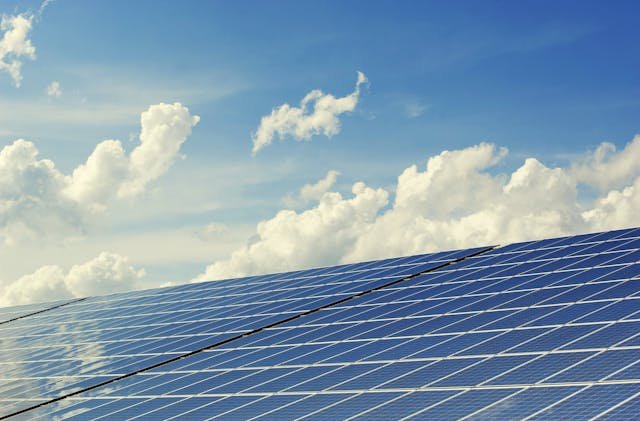
Kinetic and potential energy are like the two main families in the world of energy. But just like a family can have many different members, energy also comes in many forms — each with its own personality. All of these are really just special cases of kinetic or potential energy, but we give them different names depending on where they come from and how they behave.
Mechanical Energy – The Energy You Can See Moving
Mechanical energy is the combined effect of kinetic energy (movement) and potential energy (stored position). It’s the kind of energy you notice when something is moving or is ready to move.
Think about:
- The wheels of a skateboard spinning as you ride.
- A pendulum clock swinging back and forth.
- A seesaw with one side up and the other down — the higher side has potential energy, the moving side has kinetic energy.
Mechanical energy is what makes machines work, from tiny wind-up toys to massive cranes.
Thermal (Heat) Energy – Invisible Motion of Tiny Things
Everything you touch is made of unimaginably small particles — atoms and molecules — and they never stop moving. When they move faster, the object feels warmer. That invisible movement is called thermal energy.
Think about:
- The heat rising from toast fresh out of the toaster.
- The warmth you feel when you rub your hands together quickly.
- The way the pavement feels hot under your feet on a sunny day.
Thermal energy is really a form of kinetic energy — it’s just happening at such a tiny scale you can’t see it, only feel it.
Chemical Energy – Stored in Everyday Things
Chemical energy is a type of potential energy hidden inside materials. It’s stored in the bonds between atoms. When those bonds break or rearrange, energy is released.
Think about:
- The food you eat — your body turns it into movement and heat.
- A battery powering your TV remote.
- A matchstick bursting into flame when struck.
Chemical energy can turn into light, heat, movement — almost any other kind of energy.
Electrical Energy – The Power of Moving Charges
Electrical energy is made by the movement of tiny charged particles called electrons. It’s what powers nearly every gadget and machine you use each day.
Think about:
- Plugging in your phone charger.
- Lightning flashing during a storm.
- The hum of a fan turning on.
Electricity can also be stored (potential energy) in batteries until it’s needed.
Light (Radiant) Energy – Energy That Travels in Waves
Light energy travels in waves that can move through empty space — which is why sunlight reaches Earth from millions of kilometers away.
Think about:
- The sun shining through your bedroom window in the morning.
- A flashlight lighting up a dark room.
- The colors of a rainbow after it rains.
Light is special because it can turn into other forms of energy, like heat or electricity, and back again.
Sound Energy – Vibrations You Can Hear
Sound is made when something vibrates and those vibrations travel through air, water, or solid materials to your ears. It’s a form of kinetic energy, because it’s all about movement.
Think about:
- The strum of a guitar string.
- Raindrops tapping on the roof.
- A dog barking outside.
Without matter (air, water, or solids) to carry it, sound can’t travel — which is why space is silent.
How Energy Changes From One Form to Another
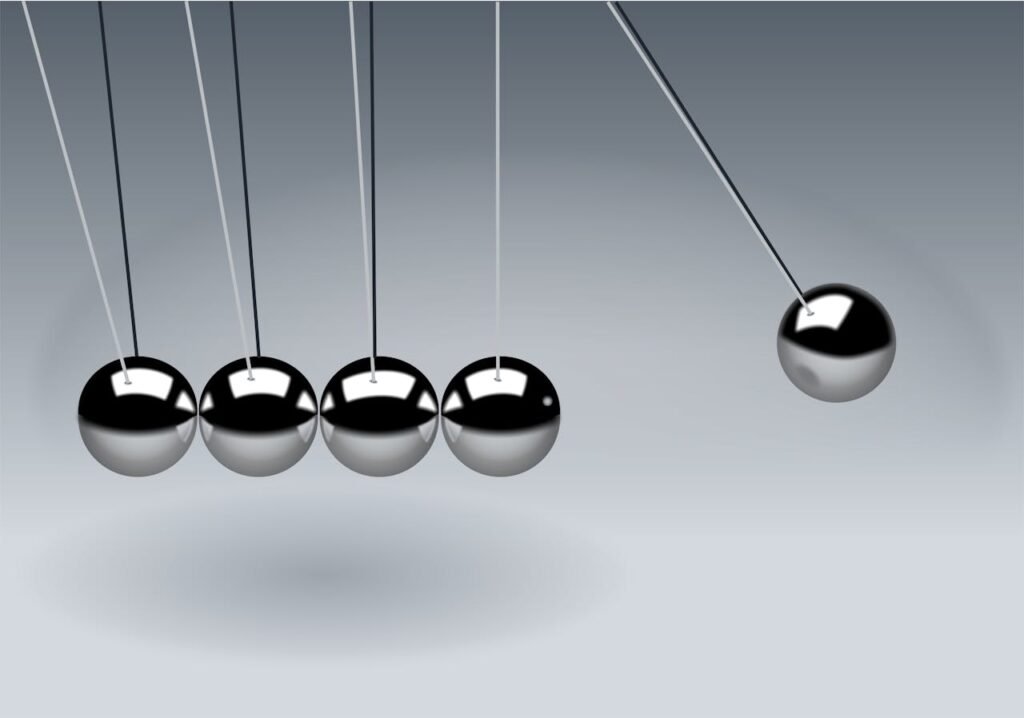
Energy is like a master of disguise — it never disappears, but it’s always changing its look. Scientists call this the Law of Conservation of Energy: energy cannot be created or destroyed; it only changes from one form to another.
This means the energy in a flying soccer ball, the warmth of the sun on your face, and the fuel that powers a car are all connected in one never-ending loop. The energy you see now might have been something completely different a few moments ago.
The Slide at the Playground
Picture yourself at the very top of a shiny playground slide. You’re sitting still, looking down at the bottom. Right now, you’re full of potential energy — stored up because you’re high off the ground.
The second you push yourself forward, that potential energy begins turning into kinetic energy — the energy of movement. You slide faster and faster, wind rushing past your ears.
But something else is happening too: friction between you and the slide is stealing a tiny bit of that motion and turning it into thermal energy (heat). You can’t feel it much, but the slide is ever so slightly warmer after you go down.
By the time you reach the bottom, your potential energy has transformed into kinetic energy and heat — but not a single drop of energy vanished. It simply changed costume.
The Journey from Sun to Soccer Goal
Energy transformations happen in much bigger chains too — let’s follow one:
- The Sun’s Gift: The sun sends light energy streaming to Earth.
- Plants at Work: Plants absorb that light and use it for photosynthesis, storing it as chemical energy in leaves, fruit, and seeds.
- You Eat Lunch: You take a bite of a sandwich — the bread, lettuce, and tomatoes all carry that stored chemical energy from plants (and maybe animals that ate plants).
- Your Body Moves: Your body breaks down the food and turns that chemical energy into kinetic energy so you can run.
- Scoring the Goal: Your moving leg sends the ball flying — now the ball has kinetic energy.
- The Final Change: The ball hits the net — some energy becomes sound as the net swishes, and some becomes heat in the ball and net fibers.
The amazing part? Every bit of that energy began as sunlight.
Energy Changes All Around You
Once you start looking for them, you’ll notice energy transformations everywhere:
- Flashlight: Chemical energy in batteries → electrical energy → light and heat.
- Toaster: Electrical energy → thermal energy that browns your bread.
- Wind Turbine: Kinetic energy from wind → mechanical energy → electrical energy in your home.
- Car Engine: Chemical energy in fuel → thermal and mechanical energy to turn the wheels.
Simple Experiments to See Energy Change
Rubber Band Launcher
- Stretch it (potential energy).
- Release it (kinetic energy as it flies).
Bouncing Ball
- Drop it (potential → kinetic).
- Watch it squish (elastic potential) and spring back up (kinetic again).
Melting Ice in the Sun
- Sunlight (light energy) warms the ice (thermal energy) until it melts into water.
These simple activities prove the same rule over and over: energy is always moving and changing — but it never disappears.
Renewable vs Non-Renewable Energy – Where Does Our Power Come From?
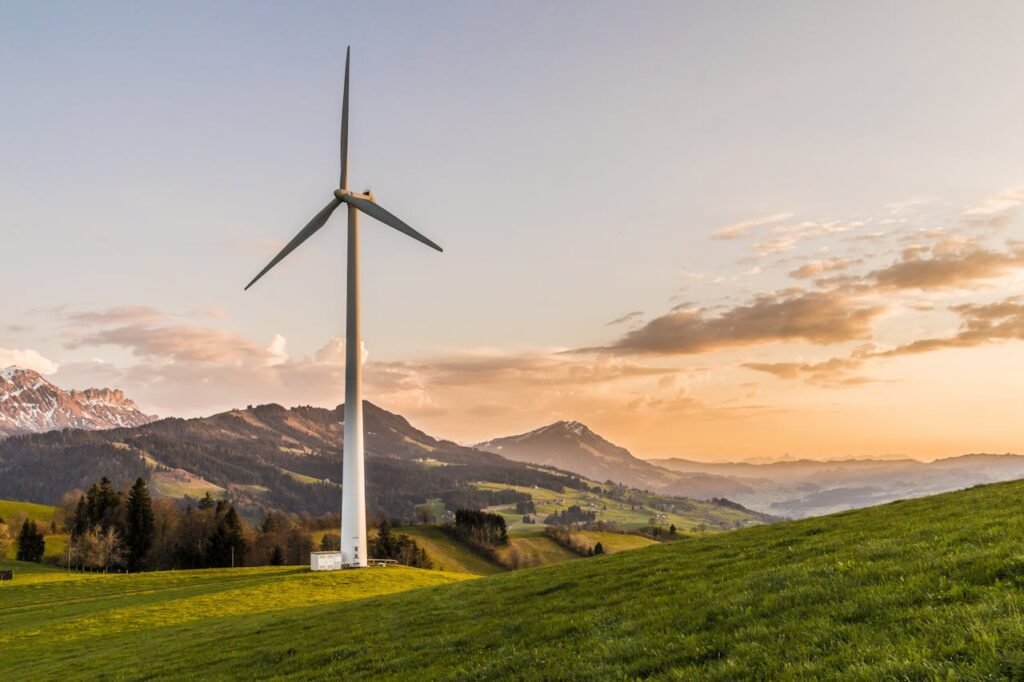
Every time you switch on a light, charge your phone, or open the fridge, you’re using energy that came from somewhere. But not all energy sources are the same. Some can be replaced easily and naturally, while others are limited and will run out if we use too much.
Renewable Energy – Nature’s Endless Supply
Renewable energy comes from sources that can be used again and again without running out. Nature replaces them quickly — sometimes instantly. These sources are clean, meaning they don’t create as much pollution when we use them.
Examples kids know:
- Solar energy – from the sun’s light and heat. Solar panels on rooftops capture it and turn it into electricity.
- Wind energy – from moving air. Wind turbines spin to make power.
- Water energy (hydropower) – from flowing rivers or waterfalls. Dams can use moving water to turn turbines.
- Geothermal energy – from heat deep inside the Earth.
- Biomass energy – from plants, crops, or waste that can be turned into fuel.
Everyday connection: If you’ve seen a solar-powered calculator or garden light, you’ve seen renewable energy in action.
Non-Renewable Energy – Limited Resources
Non-renewable energy comes from sources that take millions of years to form. Once we use them up, they’re gone for good. These sources often cause more pollution and can harm the environment if not used carefully.
Examples:
- Coal – a black rock burned to make heat and electricity.
- Oil (petroleum) – used for gasoline, plastics, and many products.
- Natural gas – used for heating homes and cooking.
- Nuclear energy – from splitting uranium atoms in power plants.
Everyday connection: The gasoline in a car’s fuel tank is a non-renewable source. Once it’s burned, it can’t be reused — it’s gone.
Why It Matters
For kids, the big idea is this: renewable energy is like a water bottle you can keep refilling, while non-renewable energy is like a chocolate bar — once you eat it, it’s gone.
If we rely too much on non-renewable sources, we risk running out and damaging the planet with pollution and climate change. That’s why scientists, engineers, and governments are working hard to use more renewable sources.
Spotting Energy Sources in Daily Life
You can help kids notice where their power is coming from:
- See solar panels on rooftops or streetlights? That’s solar energy.
- Passing a wind farm on a road trip? That’s wind energy.
- Smelling gas while cooking? That’s natural gas — a non-renewable source.
The more kids notice these connections, the more they understand that every light switch, device, and machine is part of a bigger energy story.
Everything in Between – More Fascinating Forms of Energy
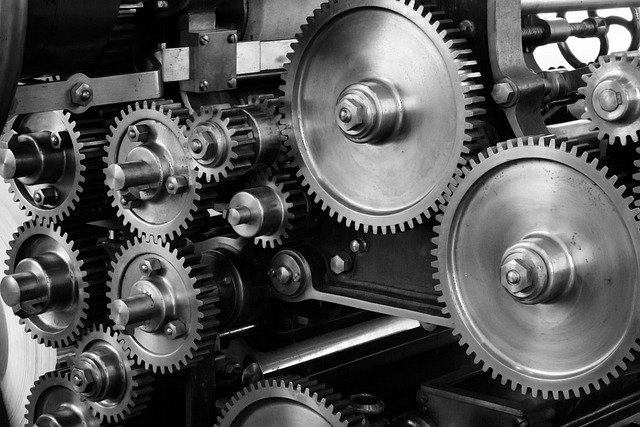
We’ve talked about kinetic and potential energy, plus common forms like heat, light, and sound. But there are other special types that don’t fit neatly into just one box — and they’re all around you.
Elastic Energy – The Power of Stretch and Squash
Elastic energy is a type of potential energy stored in things that can be stretched, squished, or twisted, then return to their original shape.
Everyday examples:
- A stretched rubber band before it snaps back.
- A spring in a toy car before you let it go.
- A trampoline surface just before it launches you into the air.
Elastic energy is like a secret spring waiting to release its power at the right moment.
Magnetic Energy – Attraction and Repulsion Without Touch
Magnetic energy comes from the force between magnets or between magnets and certain metals like iron. Magnets can pull (attract) or push (repel) without even touching.
Everyday examples:
- Refrigerator magnets holding up a drawing.
- A magnetic clasp on a purse or necklace.
- The invisible push you feel when trying to put two same-pole magnets together.
Magnets also play a huge role in technology — they’re inside speakers, motors, and even some medical machines.
Nuclear Energy – Power from the Heart of Atoms
Nuclear energy comes from the nucleus, the tiny center of an atom. It can be released in two main ways:
- Fission – splitting a heavy nucleus into smaller parts.
- Fusion – joining two light nuclei together (this is what powers the sun).
Everyday connection: Nuclear power plants use fission to create electricity for millions of homes. The sun’s fusion provides almost all the energy that life on Earth depends on.
Gravitational Energy – The Pull of the Earth (and More)
Gravitational energy is potential energy stored because of an object’s position in a gravitational field (like Earth’s). The higher something is, the more gravitational potential energy it has.
Everyday examples:
- A basketball before it drops through the hoop.
- Water stored in a high dam before it flows down to turn turbines.
- A skydiver before they start falling.
Gravity constantly converts this stored energy into movement — which is why objects always fall toward Earth unless something holds them up.
Thermal vs. Heat – A Quick Clarification
Many people think “thermal” and “heat” are the same, but they’re slightly different:
- Thermal energy is the total movement of particles in an object.
- Heat is the transfer of that energy from one object to another (like when a hot mug warms your hands).
Understanding this difference helps kids see energy as an active, moving thing — always flowing, always changing.
These “in-between” forms show that energy is not just about things moving fast or sitting still. It’s also in the stretch of a bow, the invisible pull of gravity, the hum of a magnet, and the unimaginable power locked inside atoms.
How Debsie Helps Kids Understand Energy

At Debsie, we know that energy isn’t something kids should just memorize for an exam — it’s something they should feel, see, and play with until it becomes second nature. Energy is everywhere, from the moment they open their eyes in the morning to the second they fall asleep at night. Our mission is to make sure they not only recognize it, but also understand how it works and why it matters.
1. From Theory to Touch
Reading a definition of “kinetic energy” is one thing — watching it happen in your hands is another. That’s why we use hands-on, everyday materials to turn abstract science ideas into real experiences:
- Rolling races: Students race toy cars down different ramps, then discuss how the height of the ramp changes the car’s speed (potential → kinetic).
- Elastic experiments: Kids stretch rubber bands to different lengths, measure how far objects fly, and discover the link between stored energy and motion.
- Mini water turbines: Using bottles, spoons, and water, they see how flowing water can spin blades — just like hydropower plants.
When they see and control the transformation, they remember it for life.
2. Energy in Their Everyday World
Kids light up when they realize science is already all around them. Our teachers train them to be “energy detectives,” spotting examples in daily life:
- A swing at the park is a perfect mix of potential and kinetic energy.
- The hum of a fridge is electrical energy doing its job.
- Warm sand under their feet is solar energy transformed into heat.
We encourage them to bring “energy sightings” to class so they can share their discoveries and connect lessons to real experiences.
3. Storytelling That Brings Science Alive
We turn science lessons into stories kids want to follow. Instead of simply saying “light energy changes to chemical energy,” we might tell:
- The Sun’s Secret Mission: Sunlight travels millions of kilometers to Earth, slips into a leaf, and hides as sugar inside a tomato that ends up in your sandwich.
- The Journey of a Soccer Goal: From the sandwich in your stomach to the ball hitting the net — every step powered by energy transformations.
When kids can picture energy as a character moving through different “disguises,” they never forget the process.
4. Curiosity as the Driver
We design lessons so there’s room for “What if…?” moments. If a student asks, “What if we double the height of the ramp?” — we test it. If they wonder, “What happens if we use ice water instead of warm water?” — we find out.
This freedom to explore builds critical thinking and helps kids see science as a living subject, not a fixed set of facts.
5. Practice That Builds Confidence
By the end of a Debsie energy unit, students can:
- Identify different forms of energy without hesitation.
- Predict how energy will change in a given situation.
- Explain transformations clearly, using their own words.
We use games, mini-projects, and creative challenges so they practice these skills until they feel completely natural.
When kids leave our classes, they don’t just “know about” energy — they can spot it, explain it, and use it to understand the world.
Conclusion
Energy is everywhere — in every movement, every sound, every light, every breath. When children understand it, they don’t just learn a science topic; they unlock a way of thinking that helps them understand the world. They see the hidden connections between cause and effect, they ask sharper questions, and they grow more confident in exploring new ideas.
At Debsie, we make this learning simple, exciting, and unforgettable. We turn energy from a “school subject” into a daily discovery, giving kids the skills and curiosity to think like scientists and problem-solvers.
The best part? This is learning they’ll carry for life.
🌟 Give your child the gift of real understanding.
👉 Book a free trial class today and watch them light up with curiosity.
Read next:
